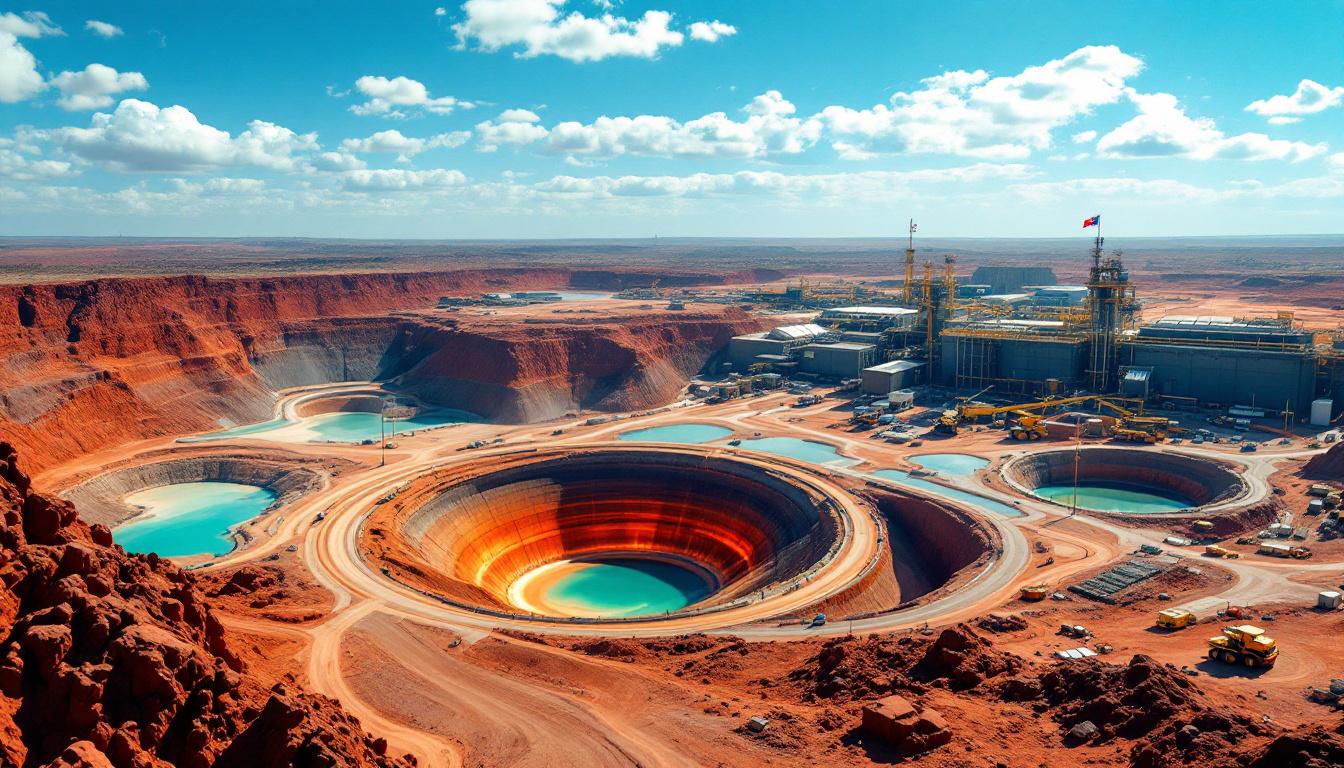Why Are Tin Prices Surging in 2025?
Tin prices surge as DRC operation closes, sparking a volatile market in 2025. The global tin market has experienced unprecedented disruptions, with prices reaching eight‐month highs. Investors and industry experts alike are realising the impact, as supply shocks coincide with growing technological demand.
This surge reflects wider supply challenges. Recent events echo findings in global commodities market insights.
What Caused the Recent Tin Price Spike?
The primary catalyst was the unexpected closure of Alphamin's Bisie mine in the Democratic Republic of Congo. In early March 2025, escalating unrest forced the evacuation of most personnel. Only a small team remained for essential maintenance.
This closure removed about 17,000 tonnes of tin annually – over 4% of global supply. This loss led to an immediate jump in tin prices on the London Metal Exchange, peaking near US$34,815 per tonne.
Industry analysts note that supply chain vulnerabilities were already present. For additional market perspectives, check out a recent tin price report.
How Are ASX-Listed Tin Producers Benefiting?
Australian producers have benefitted from the supply crunch. Metals X (ASX:MLX) saw its share price jump 26.19% to a three-year high of 69 cents. This improvement comes on the back of record quarterly production at its Renison Tin Operation in Tasmania.
The company attributes performance improvements to enhanced recovery rates and increased processed mined tonnes and grades. For a deeper dive into production strategies, see navigating mining investments and geological insights.
Other companies, such as Elementos Ltd (ASX:ELT) and Stellar Resources (ASX:SRZ), have seen growing investor interest. As tin prices surge due to the DRC disruption, market participants are re-evaluating their positions.
What Is Tin Used For in Modern Technology?
Tin is an unsung hero in modern technology. Its low melting point of 232°C and excellent wettability make it ideal for electrical soldering. Tin is used in 52% of solder materials for semiconductor manufacturing.
Electronic devices from smartphones to autonomous vehicles depend on tin for reliable electrical connections. As one analyst remarked, “there is simply no viable substitute for tin in high-precision soldering.”
Its role extends to touchscreens, lithium-ion batteries, and catalysts. Recycling remains low, with only 30% being recovered. This inefficiency heightens market sensitivity when supplies are disrupted.
How Is the Gold Market Performing in 2025?
Gold has staged a quiet rally alongside tin market turmoil. Currently trading at US$2,996.59 per ounce (A$4,770.89), gold is nearing the US$3,000 mark. Macquarie’s research team predicts that gold could reach US$3,500 per ounce by Q3 2025.
Safe-haven demand is fuelling this momentum. A well-detailed gold market analysis and 2025 predictions suggests that factors like US debt concerns and Federal Reserve policies underpin this trend. Investors see gold’s rise as a counterbalance in uncertain times.
Which ASX Gold Miners Are Seeing Benefits?
ASX-listed gold miners are capitalising on this trend. Pantoro Limited (ASX:PNR) recently achieved a two-year high of 16.5 cents, reflecting a 10% increase on exceptional trading volume.
The company reported a 30% increase in production, reaching 40,812 ounces at its Norseman project, while keeping costs disciplined. Pantoro’s progress has drawn comparisons to understanding the JORC code for mining investments as investors seek transparency in resource metrics.
Meeka Metals (ASX:MEK) is similarly impressive. Its flagship Murchison Gold Project boasts 1.2 million ounces at 3g/t, supporting a long-term production plan. The robust performance of these companies underlines gold’s status as a key safe-haven asset.
What Other Resources Are Seeing Market Movement?
Other resource sectors are also experiencing dynamic changes. Renergen (ASX:RLT) recently surged 70% after achieving a cryogenic milestone at its Virginia Gas Project in South Africa.
Key achievements include filling its first helium container with liquid helium at -269°C. This breakthrough demonstrates the company’s advanced technological capabilities and opens up further commercial opportunities.
In another example, Bowen Coking Coal (ASX:BCB) recorded a 142% improvement in EBITDA, despite a 16% decline in coking coal prices. Operational enhancements at the Burton Mine have played a key role. Moreover, increased production efficiency has positioned these companies favourably in face of market headwinds.
What’s Driving Gold’s Safe-Haven Status?
Gold’s safe-haven status is driven by an array of interconnected factors. Political uncertainty, along with fears over US debt and fiscal deficits, has spurred investors to seek reliable assets.
Tariff uncertainties and rising pressures on monetary policy further strengthen gold’s appeal. As analysts note, structural deficits and prolonged market instability make gold an attractive refuge.
Central banks expanding their gold reserves and institutional inflows are clear indicators. For further context on market conditions and risk, consider reading about esg challenges in the mining industry.
How to Interpret Current Commodity Market Trends
Several key takeaways can guide investors navigating the commodity landscape today:
- Supply disruptions can rapidly disturb global markets.
- Critical minerals with concentrated production, such as tin, are particularly vulnerable.
- Diverse assets like gold benefit from safe-haven demand during geopolitical uncertainty.
- Operational improvements can offset market headwinds even in challenging environments.
The intersection of these dynamics is crucial for investors looking to position themselves advantageously.
Notably, the recent tin supply shock – where tin prices surge as DRC operation closes – highlights the broader implications. This event has prompted market participants to re-examine production dependencies and risk profiles across the board.
Frequently Asked Questions About Tin and Gold Markets
What is driving the current tin price surge?
A primary driver has been the closure of Alphamin's Bisie mine in the DRC. The disruption removed approximately 17,000 tonnes of production per annum from the global market. This event has emphasised underlying vulnerabilities in tin production.
How significant is the Bisie mine closure to global tin supply?
The closure is extremely significant. The mine supplied over 4% of global tin. With integrated supply chains and limited substitutes, this shock underscores why tin prices surge as DRC operation closes.
Why is gold approaching record price levels in 2025?
Gold’s rising prices are a result of heightened safe-haven demand amid geopolitical and fiscal uncertainty. Continued central bank buying and subdued real interest rates further support this trend.
Which ASX-listed companies offer exposure to rising tin prices?
Metals X, Elementos Ltd, and Stellar Resources provide direct exposure. Metals X, specifically, stands out due to its substantial production at the Renison Tin Operation.
How are gold producers capitalising on the current price environment?
Companies like Pantoro Limited and Meeka Metals are leading the way. They benefit from operational efficiencies and improved production metrics, allowing them to focus on growth and shareholder returns.
Tin prices surge as DRC operation closes has become the leitmotif for early 2025 market dynamics. The recurring theme underlines the risks and opportunities in this volatile market, driving both speculative and long-term investment strategies across the commodities spectrum.
Want to Stay Ahead of Major Mineral Discoveries on the ASX?
Discovery Alert's proprietary Discovery IQ model instantly identifies significant mineral discoveries like potential tin or gold opportunities, giving you a crucial market advantage before the wider market reacts. Explore how past discoveries have generated exceptional returns by visiting the Discovery Alert discoveries page today.




